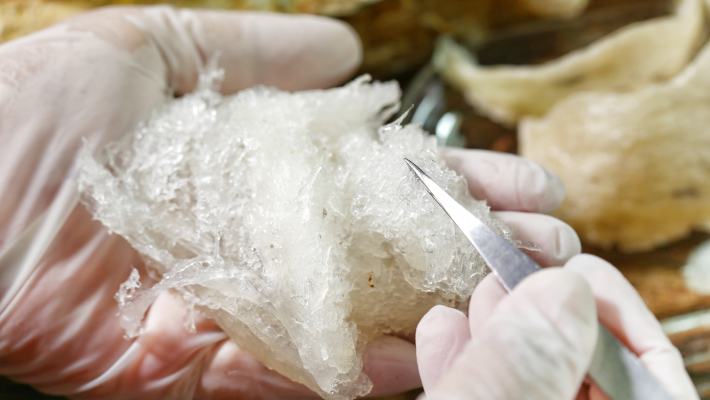Edible bird’s nest discovery lays the foundation for further studies in skin health
Edible bird's nests (EBNs) have been consumed as a delicacy and traditional health tonic for centuries, with the nests believed to have antioxidant, antiinflammatory, and anti-ageing properties, among other benefits. Much research has been conducted into the efficacies associated with the consumption of EBNs. However, the active ingredients in EBN responsible for these benefits remain largely unknown.
A research team from the PolyU Academy for Interdisciplinary Research recently constructed the first genome of EBN-producing swiftlets, establishing an important foundation for subsequent studies on the efficacies of EBNs.
First-ever EBN-producing swiftlets' genome developed
EBN are saliva-cemented nests built by only a few swiftlet species found in Southeast Asia. Dr Kong Hang-kin, Research Assistant Professor of the Department of Food Science and Nutrition; Dr Wong Ka-hing, Director of the Research Institute for Future Food; and their research team collected live specimens from swiftlet houses in Indonesia, and then extracted, sequenced and assembled the genomic DNA to produce the first genome of the EBN-producing swiftlets.
Protein domains related to epidermal growth identified

The PolyU researchers compared the genes of the swiftlets with ten other avian species, including chickens, turkeys and mallards. They found that the swiftlets have multiple copies of a gene that encodes for a protein known as ‘coiled coil domain containing protein 63’ (CCDC63) while most of the other avian species only have a single copy of CCDC63 gene. The CCDC63 gene is an important protein to many different cell types. Researchers suspected that having multiple copies of this gene may affect the functions in these cell types.
With the genome, researchers identified a total of 398 proteins in EBNs, including some that are unique to EBN-producing swiftlets. The analysis also revealed that EBN contained various extracellular proteins and other proteins related to various biological functions, such as immune functions. The research team will conduct further studies to investigate growth promoting effects of the epidermal growth factor-like domains on human skin. The PolyU study has not only revealed the speciesspecific genotype of EBN-producing swiftlets, but also the proteome of EBNs, which provides a genomic data base to support proteomic analysis of EBNs in the future.
The PolyU study has not only revealed the speciesspecific genotype of EBN-producing swiftlets, but also the proteome of EBNs, which provides a genomic data base to support proteomic analysis of EBNs in the future.
This research paper was published in Food Research International in October 2022.
| Study highlights importance of choosing extraction methods The study also discovered that extraction methods have significant impacts on the biological activities of the extracts from EBNs. Therefore, attention should be paid to using suitable extraction methods to preserve the biological activities of extracts from EBNs for subsequent functional tests. |






